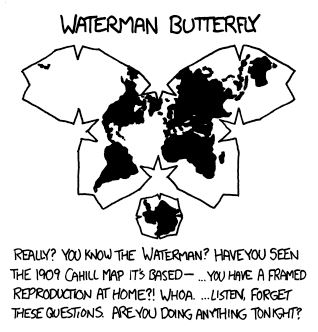Not only is NZ on this map but it’s not even way off in the corner!
I’m happy for NZ but it might be a good idea to stay hidden for the time being.
We need a maps without nz Lemmy house
Front and center!
-ish!
We drawing maps for 2000 years now experience pays out. :D
That one little fella in South America - must have been confusing as fuck for them.
Is the only one Brazil ever recognized as a hurricane. But it’s believed that they happen every once in a while, they are just not classified correctly.
Why wasn’t it recognised as a cyclone? Was it spinning backwards?
As a hurricane, not as a cyclone. There’s a minimum intensity necessary to get classified as a hurricane.
(I’ve written cyclone by mistake, and changed the comment. You may be reading an older version of it.)
Poor thing. It set off and realized it was lost.
Can someone smarter than me explain why South America is seemingly immune to hurricanes?
I also want to know this.
https://www.ncesc.com/geographic-pedia/why-do-hurricanes-not-hit-south-america/
According to this, TL;DR- South America is further from the swirling warm winds of the topics than it looks, and the ocean temperatures are colder compared to the hurricane prone areas too due to how the oceanic currents work.
Rainy season in Northern Africa has a lot of land to form storms from sand as cloud seeds. Gulf and Carribean sea are almost always hot in summer. Relatively shallow. Northern South America also has rainy season and helps form storms that go north.
South America doesn’t get as much help from Africa storm formation, and south atlantic does not have a history of being very hot.
The Coriolis Force | https://www.youtube.com/watch?v=_36MiCUS1ro
I’m digging that one hurricane in south America that looks lost.
Ole, “wrong-way Carlos”
I think a better question is why are the northern hemisphere hurricanes so much more feathery and beautiful than those raggedy ass southern hemisphere hurricanes and tropical storms.
Because there are way more in the northern hemisphere I assume ? Probably due to greater differential between water and air temp in general in the northern hemisphere due to currents and shit
Indeed!
Im certain that’s because of tornado related physics and things. 👍
I’m guessing it’s because they rotate in different direction in the northern and Southern hemisphere.
So crossing would imply switching direction, which would require to put that energy “somewhere” and it’s physically not possible.
No. It’s because the earth spins faster there. Them turning a certain direction is a result, not a cause.
A) The Earth spins at the same speed. What you are talking about is the tangential speed.
B) The tangential speed is not much faster at the equator than 100km South or North of it.
C) The speed difference would not explain why they don’t cross the equator. It may explain (partially) why there are no hurricanes further away from the equator.
I love it when people use bulletpoints to seem smart when they are so confidently wrong
Considering that I did not use bullet points, I guess you are talking about yourself 🤣
For someone being so hyper pedantic you failed to realize they didn’t use anything even close to bullet points.
Wow! Tough crowd. Seriously, at least I explained my reasoning for why hurricanes do not cross the equator. All they did was make either wrong or poorly formulated claims without any kind of explanation, and then throw insults.
Saying that “The Earth spins faster” makes no sense, especially in this context: why would the equator spin significantly faster than 100km away from it?!? And why would this negligible speed difference prevent hurricane from crossing that line?
If you want to correct someone, at least do it right.
Oh man, I didn’t realize that Oman got hit by tropical storms.
it’s wild to think that we here in the nordics are apparently less safe from them than people in most of africa are!
really interesting. what’s the reason why?
Stole explanation from r/ELI5:
When you stand on the north pole how fast are you moving relative to the earth’s core?
Zero, you just spin around in place once every 24 hours.
When you stand on the equator how fast are you moving?
1000mph, you have to circumnavigate the earth in a day.
This difference doesn’t matter much when you throw a baseball, but it absolutely matters when you’re a storm the size of a country. > This disparity in relative speed rotates the storm since the equatorial side is moving faster than the polar side, and it provides the swirling structure of the hurricane.
But here’s the problem - storms in the north spin counter-clockwise and storms in the south spin clockwise.
That means to cross the equator you have to stop and reverse direction. That’s not happening, and hurricanes never track near the equator because neither the storm itself nor the prevailing winds that push it around can approach this reversal boundary.
The equator itself is associated with very low wind speeds, aka the doldrums.
Ah, the calm belt.
Probably Coriolis effect? I’m not a professional meteorologist but I am an amateur meteorologist. I live in New Orleans and hurricanes follow somewhat predictable patterns. (Maybe not always where you can pinpoint exactly where they’re going but they tend to turn north in the northern hemisphere and south in the southern hemisphere.)
You can also look at some of the coastlines and see the millions of years of erosion from the same patterns once the continents moved more into what we have now.
The coriolis effect is a fictitious force, it’s just an artifact of not doing measurements in an inertial reference frame.
Edit: If I were to attribute it to anything, I’d attribute it to the actual rotation of the earth.
As the highs lows are part of the earth’s atmosphere and thus trapped in a non-inertial frame of reference, they indeed experience the fictitious forces, such as the Coriolis and the centrifugal force.
The coriolis effect is not an actual force, that’s all I’m saying.
Which is why we call it the Coriolis effect rather than the Coriolis force
If you’ve ever heard of sailors talking about ‘the doldrums’ the calm bit is the doldrums.
I’m going to say the Coriolis effect but… I don’t know?
Interesting that the western Pacific seems to have so many more category 5 than the Atlantic, and while the South Pacific and Indian Ocean have plenty, the South Atlantic has basically none.
🎶ECUADOR! 🎶
Philippines truly drew the short straw here
Getting hammered.
Massive if true.
A yo mama joke that only works with this context:
Yo momma’s ass so fat, no hurricane dares to cross her ass crack.
The form above 10^* lattitude. Their natural direction is to go straight towards their respective poles, but high pressure systems steer them with the trade winds. Extremely rare for a storm to even go slightly towards the equator












